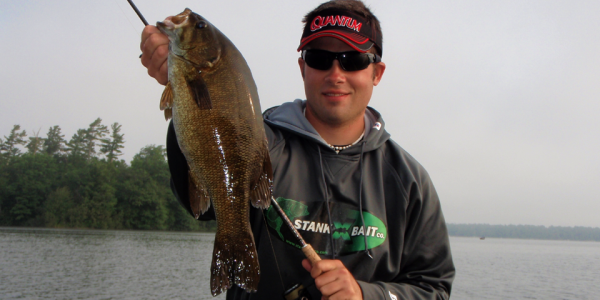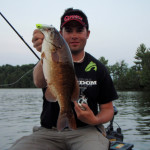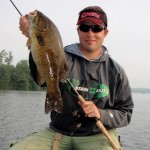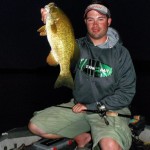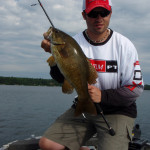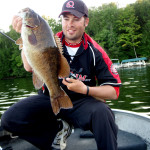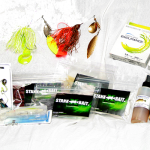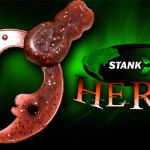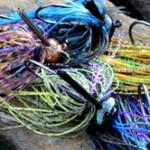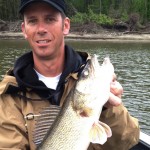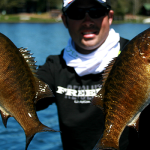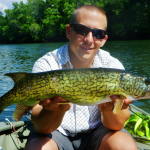By Andrew Ragas
Wisconsin is a great state for catching smallmouth bass, not just for number of lakes but outstanding management and conservation practices. Excellent fishing is had spring through fall, but the most challenging, rewarding, and consistent fishing of the season takes place in summer.
Where I fish on the inland waters of Vilas, Oneida, Iron, Price, and Forest Counties, I am blessed to have hundreds of lakes and rivers to fish where big smallmouth bass are caught frequently.

Good friend Christopher Stolarski holds one of his 4 pounders caught on a mid-summer adventure with the author.
Where to Go
Good populations of smallmouth bass are present in most places. Nearly every productive smallmouth lake I’ve fished contains clear to moderately stained cola-brown water, and features a habitat comprised of sand, rock, gravel, wood, and some weed growth that is mostly occupied by pelagic baitfish and other juvenile species.
Traditional smallmouth lakes during the summer season offer deep and cool water. However, the best lakes contain depths of everything from shallow to deep, and somewhere in between.
Some of the most incredible bodies of water I have ever launched my boat at possess a maze of transitions from shallow to deep water and underwater contour. Such examples are shelves, drop-offs, rock bars, sand bars, sunken islands, trenches, and fields of boulders. Any time you are faced with a lake offering all of this, it will be a smallie paradise. In my opinion, lakes offering too many specific spots to fish in one single day are the places worth spending your most time at.
Although smallmouths are present in most lakes containing the aforementioned variables, big water and lakes larger than 1,000 surface acres are places that will usually contain the bigger fish along with substantial numbers of them too. As opposed to smaller lakes, 50 to 200 acres, that might not receive as much angling pressure, lake size and available habitat are the deterring factors that limit the number of big fish being present. One of the most common axioms in fishing is that big water grows an abundance of big fish. In the case of smallmouth bass, this goes undisputed
Once you have your lake selections made and defined fish locations figured out, it’s time to combat the challenges and rewards brought forth by summer fishing.
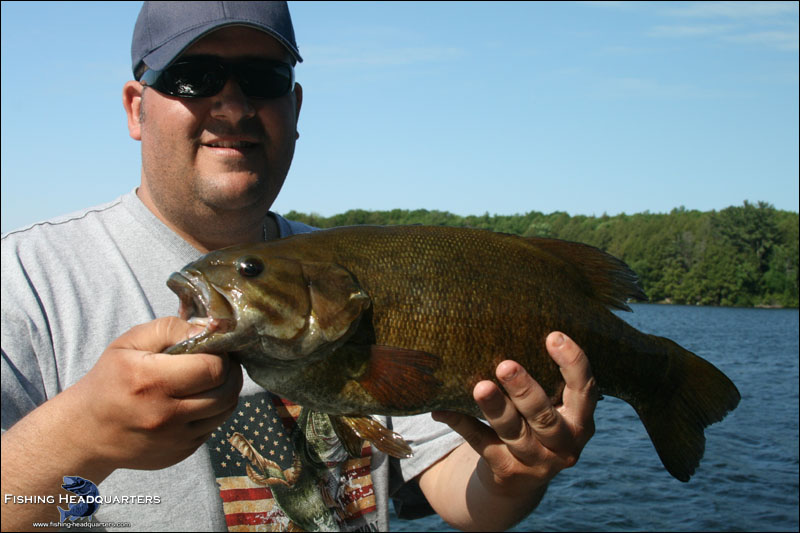
Summer Strategy
In summer, there are two characteristics I look for, that will lead me to good fishing: Depth, and water clarity. I head to the clearest and coldest waters I can find. When you get there, good marine electronics will help in locating deep suspending fish, and good spots, considerably.
Gin clear waters greatly intimidate anglers, driving them away from some of the best smallmouth waters there are. However, smallmouths easily counter and often oblige, striking baits from great distance aided by bright sunlight and its Smirnoff colored water. During this time of year, smallmouths are substantially easier to catch from clear water than murky brown and dark water environments. These clear waters also contain the better, trophy fisheries, and cooler water temperatures smallmouths favor most.
Smallmouth are adept visual feeders that are most active in sunny daytime conditions. Most anglers believe that lowlight, overcast days fare best on clear bodies of water. With smallmouths being more active during daytime, and most responsive to sunlight and in a happier mood as visual feeders, don’t let water clarity prevent you from catching. This will work to your advantage if choosing the proper lures, presentations, and colors. Due to their keen eyesight, anglers must disguise their lures and alter their approach, which calls for finesse and matching the hatch.
Keeping your baits looking as natural as possible, in appearance and movement, is the trick to catching fish consistently throughout summer. Scaling down with natural baits that have the abilities to match the hatch is a technique I select for fishing clear water. Strike King coffee tubes, YUM craw bugs, Kalin’s lunker grubs and Bass Pro Shops Tournament Series Caterpillar Grubs on a minnow head, and jigworms fished with 1/8 oz. to ¼ oz. heads will usually do the trick. Additionally, power shotting and 4 inch soft jerkbaits in fluke style are effective too. Natural colors representing crayfish and baitfish such as black, brown, pumpkin, sand, smoke, motor oil, and white are excellent choices, as is a natural more subtle approach to working the bait such as swimming, dead sticking, and dropping.
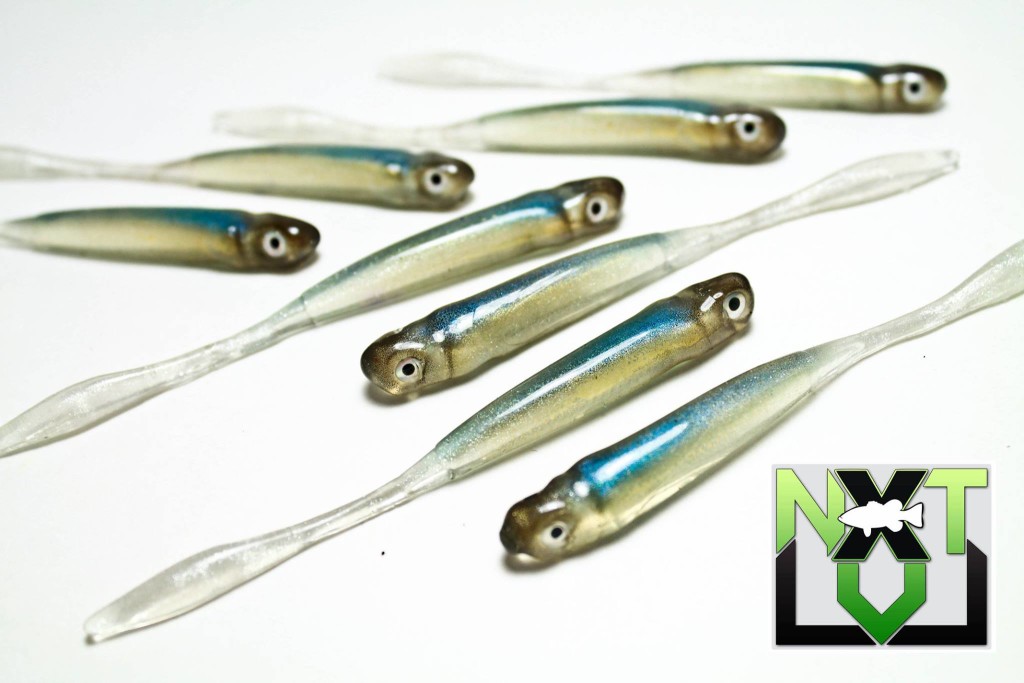
Stankx Bait Company 4″ Squirtz
If not adept with fishing soft plastics on a jig, consider power fishing techniques. Ripping jerkbaits, burning crankbaits and spinnerbaits, crawling the Carolina rigged soft plastic, and popping or walking a surface topwater will score giant fish as well.
Summertime smallmouths can be caught on any presentation as long as it works for the lakes being fished, but experimentation and adapting to conditions and fish location are the most important procedures anglers can make.
In most lakes I fish, and unless it’s a coldfront, dusk or after-dark (which is when they will move shallow), smallmouths often feed along the deep secondary dropoffs which may be situated in 10 to 20 feet, and in some lakes even substantially deeper depending upon depth of thermocline. These areas tend to have 45-degree angled slopes and they’re easy to find by observing the lake’s shorelines and upland banks. Additionally, smallmouths also tend to move offshore and spend a lot of their time on, and suspended off of, deep structure. Anglers perceive these fish to be more difficult to catch, but that’s because proper techniques and mind-set aren’t being applied. In order to catch these deeper fish, patience is the keyword. And fishing slower and methodically with the techniques highlighted above is the necessary tactic.
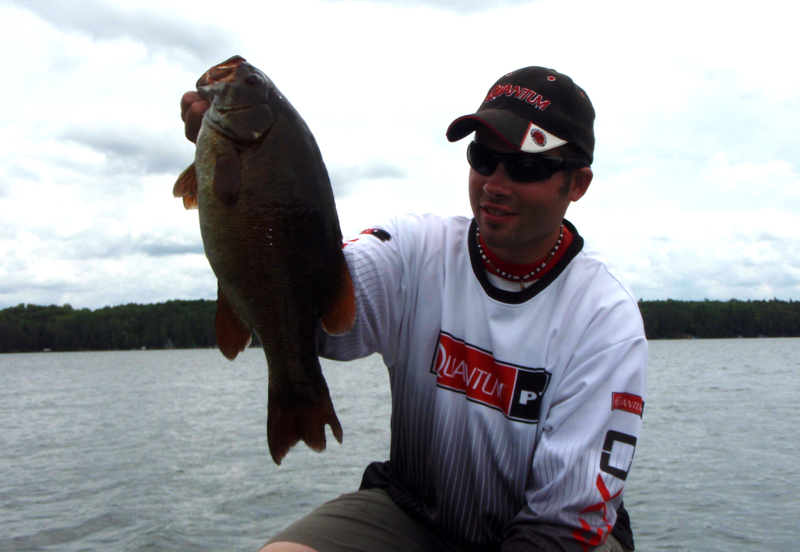
Clear water results in spookier, more wary fish. Spookier, wary fish leads to deeper daytime locations for feeding and cool water sanctuaries. On these lakes, don’t be the bank hugging guy fishing the shallows containing fewer and more difficult-to-catch fish. Locate the fish deeper along areas of contour and structure with electronics, as most of the time these will be their locations.
More than anything and often overlooked, smallmouths mainly use deep water as an invisible source of cover. Meaning, they can hide in darker, deeper water and still ambush prey by trailing open schools of ciscoes and smelt. To combat open water fish, be sure to be equipped with modern fish locators and boat electronics.
Don’t let clear water and depth frustrate you. These two characteristics are the keys to good summer fishing. Follow this simple guide and be prepared to fish slower, subtle, and stealthier. Unlike anglers, I doubt smallmouths read articles, so chances are you’ll have the upper hand and a better clarity for succeeding in summer.
Be sure to visit my new angling and fishing guide service website, specializing exclusively on Northern Wisconsin trophy smallmouth bass fishing – www.northwoodsbass.com


